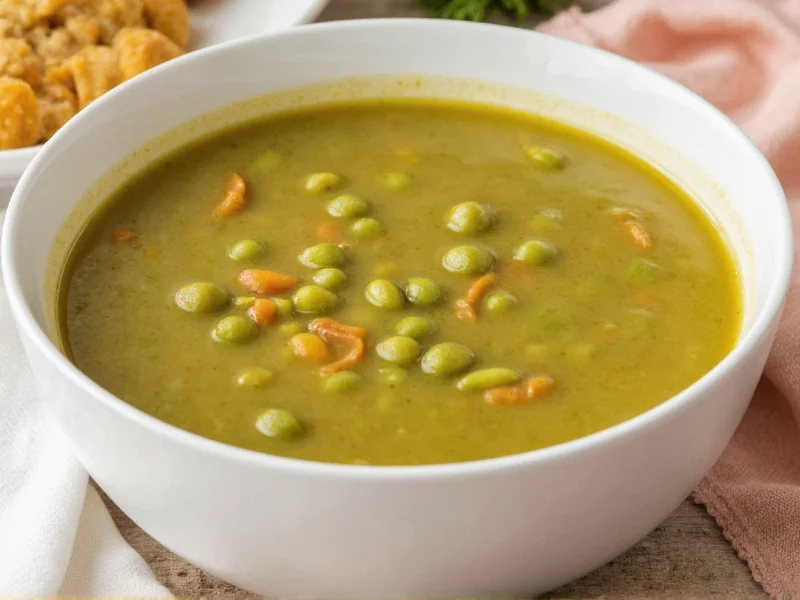Creating delicious split pea soup doesn't need to be complicated or time-consuming. This straightforward recipe delivers creamy, flavorful results with minimal effort—perfect for weeknight dinners when you want something hearty without the hassle. As someone who's tested dozens of variations over the years, I've perfected this method to eliminate common pitfalls while maximizing flavor.
Why This Easy Split Pea Soup Recipe Works
Unlike traditional recipes requiring ham hocks or lengthy cooking times, this vegetarian-friendly version achieves depth of flavor through proper vegetable sautéing and strategic seasoning. The key is understanding that split peas naturally break down during cooking, creating that signature creamy texture without needing cream or pureeing.
Simple Split Pea Soup Ingredients
This easy split pea soup recipe no ham variation uses pantry staples you likely already have:
| Ingredient | Amount | Substitution Options |
|---|---|---|
| Dried green split peas | 1 cup (200g) | Yellow split peas (slightly sweeter) |
| Vegetable broth | 4 cups (950ml) | Chicken broth or water with bouillon |
| Yellow onion | 1 medium, diced | Shallots or leeks |
| Carrots | 2 medium, chopped | Parsnips for earthier flavor |
| Celery stalks | 2, chopped | Fennel bulb for anise notes |
| Garlic cloves | 2, minced | 1 tsp garlic powder in a pinch |
Step-by-Step Instructions for Quick Split Pea Soup
Follow these simple steps for split pea soup ready in 45 minutes without compromising flavor:
- Saute vegetables: Heat 1 tablespoon olive oil in a large pot over medium heat. Add onion, carrots, and celery. Cook 5-7 minutes until softened but not browned.
- Add garlic: Stir in minced garlic and cook 1 minute until fragrant.
- Combine ingredients: Add split peas and vegetable broth. Do not add salt yet—it can toughen peas during cooking.
- Simmer: Bring to boil, then reduce heat to low. Cover and simmer 35-40 minutes, stirring occasionally, until peas have broken down and soup has thickened.
- Season: Remove from heat. Stir in 1 teaspoon salt, 1ⁿ⁴ teaspoon black pepper, and 1 bay leaf. Let sit 5 minutes to allow flavors to meld.
- Adjust consistency: For thicker soup, simmer uncovered 5 more minutes. For thinner soup, add 1ⁿ⁴ cup broth or water.
Common Mistakes to Avoid in Simple Split Pea Soup
Even the easiest split pea soup recipe can go wrong without these crucial tips:
- Don't skip the vegetable sauté: Cooking onions, carrots, and celery first builds flavor depth that boiling them with peas cannot match.
- Avoid adding salt too early: Salt during cooking prevents peas from softening properly. Wait until the end.
- Don't overcook: 40 minutes is usually sufficient. Extended cooking makes soup gluey rather than creamy.
- Resist stirring too much: Excessive stirring can break down peas too quickly, creating an unpleasant texture.
Storage and Reheating Instructions
This quick split pea soup for beginners actually improves in flavor the next day as ingredients meld:
- Refrigeration: Store in airtight container for up to 5 days. Soup will thicken as it sits—add broth when reheating.
- Freezing: Freeze portions for up to 3 months. Thaw overnight in refrigerator before reheating.
- Reheating: Warm gently over medium-low heat, stirring occasionally. Add liquid as needed to reach desired consistency.
Flavor Variations for Your Easy Split Pea Soup
Once you've mastered the basic split pea soup recipe, try these simple customizations:
- Smoky version: Add 1ⁿ⁴ teaspoon smoked paprika or a few drops of liquid smoke
- Herb-infused: Stir in 1 tablespoon fresh thyme or 1 teaspoon dried rosemary with the broth
- Creamy finish: Swirl in 2 tablespoons coconut milk or heavy cream before serving
- Protein boost: Add 1 cup cooked diced ham during the last 10 minutes of cooking
Why This Recipe Is Perfect for Beginners
This simple split pea soup with minimal ingredients succeeds where many recipes fail by eliminating unnecessary steps while preserving authentic flavor. Unlike versions requiring meat or lengthy preparation, this approach delivers satisfying results with true weeknight practicality. The forgiving nature of split peas means minor timing variations won't ruin your soup—a crucial feature for novice cooks.
Frequently Asked Questions
Do split peas need to be soaked before making soup?
No soaking required for this recipe. Split peas are pre-split and cook relatively quickly compared to whole legumes. Soaking can actually cause them to become mushy during cooking.
Why is my split pea soup too thin?
If your soup hasn't thickened sufficiently after 40 minutes, continue simmering uncovered for 5-10 more minutes. Split peas release starch as they cook, naturally thickening the soup. Avoid adding thickeners like flour which can alter the delicate flavor.
Can I make this split pea soup in a slow cooker?
Yes, but with modifications. Sauté vegetables first, then transfer to slow cooker with other ingredients. Cook on low for 4-5 hours. Do not cook longer than 6 hours or the soup may become gluey.
How do I fix split pea soup that's too thick?
Gradually stir in additional broth or water, 1ⁿ⁴ cup at a time, until reaching your desired consistency. Remember that soup continues thickening as it cools, so aim for slightly thinner than perfect when serving.
What's the difference between green and yellow split peas?
Green split peas have a slightly earthier flavor and maintain more texture, while yellow peas are milder and break down more completely. Both work well in this recipe, though yellow peas create a smoother final texture.











 浙公网安备
33010002000092号
浙公网安备
33010002000092号 浙B2-20120091-4
浙B2-20120091-4